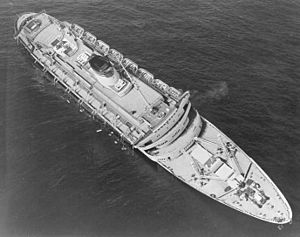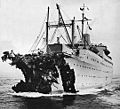SS Andrea Doria facts for kids

The SS Andrea Doria, hours before she sank on July 26, 1956
|
|
Quick facts for kids History |
|
|---|---|
| Name | Andrea Doria |
| Owner | Italian Line |
| Port of registry | |
| Builder | Ansaldo Shipyards of Genoa, Italy |
| Launched | 16 June 1951 |
| Maiden voyage | 14 January 1953 |
| In service | 16 June 1951 |
| Out of service | 26 July 1956 |
| Identification | |
| Fate | Capsized and sank on 26 July 1956, after colliding with the MS Stockholm |
| Status | Wrecked, lying on starboard side on the sea floor |
| General characteristics | |
| Class and type | Andrea Doria class ocean liner |
| Tonnage | 29,083 GRT |
| Length | 213.80 m (701 ft 5 in) |
| Beam | 27.50 m (90 ft 3 in) |
| Installed power | Steam turbines |
| Propulsion | Twin propellers |
| Speed | 23 kn (42.60 km/h) |
| Capacity | 1,241 passengers |
The SS Andrea Doria was a large Italian ocean liner, which is a passenger ship designed to cross oceans. It was owned by a company called the Italian Line. Many people thought it was the biggest, fastest, safest, and most beautiful ship in Italy after World War II. It could carry 1,221 passengers and 563 crew members.
This impressive ship was built by the Ansaldo Shipyards in Genoa, Italy. It was launched, meaning put into the water for the first time, on June 16, 1951. Its first official trip, called its maiden voyage, was on January 14, 1953. Just three years later, in 1956, the Andrea Doria crashed with another ship, the MS Stockholm, in the Atlantic Ocean. At the time of the crash, 1,134 passengers and 572 crew were on board. The Andrea Doria sank in about 11 hours, but the Stockholm survived.
The Andrea Doria was the last big ocean liner to sink before airplane travel became very popular for crossing oceans.
Contents
Building the Andrea Doria
The Andrea Doria was built at the Ansaldo Shipyards, a shipbuilding company located in Genoa, Italy. When it was built, the ship was:
- 697 feet (212 m) long
- 90 feet (27 m) wide
- It weighed 29,100 gross tons
- It could hold 1,221 passengers
- It could hold 563 crew members
The ship was designed to be very comfortable for its passengers. An Italian architect named Minoletti was its designer. There was also another ship, the Cristoforo Colombo, which looked exactly like the Andrea Doria.
The Andrea Doria was a transatlantic ocean liner, meaning it regularly crossed the Atlantic Ocean. It was special because it had three swimming pools, being the first ship ever to have so many. More than 1 million dollars were spent on art to decorate the ship's inside.
Safety Features and Design
The ship was also built with many safety features. It had 11 watertight compartments. These are special sections inside a ship that can be sealed off to stop water from spreading if there's a leak. The design meant that even if two of these compartments filled with water, the ship should not sink. The Andrea Doria also had very advanced radar technology. Radar could warn the captain if there was something in the ship's path.
However, the ship had one known issue: it often tilted too much to one side when turning. This was a problem because the Andrea Doria had two rows of lifeboats, which are small boats used to help passengers escape if the ship sinks. If the ship tilted too much, half of these lifeboats could not be used because they would be too high off the water or too close to it. The Andrea Doria's first trip was on January 14, 1953.
The Collision: A Night in the Fog
The Andrea Doria sank during the night of July 25, 1956, and into July 26, 1956. When it sank, Captain Piero Calamai was in charge, and there were 1,134 passengers and 572 crew members on board. The ship was sailing in the Atlantic Ocean on its way from Genoa, Italy, to New York, in the United States.
As the Andrea Doria passed by Nantucket, a small island near Massachusetts, it entered a very thick fog. Soon, another passenger ship, the SS Stockholm, also entered the fog. Because of the dense fog, the two ships could not see each other clearly. When they finally noticed each other, both captains tried to turn their ships away. The Andrea Doria turned left, hoping to pass the Stockholm on its right side. But the Stockholm turned right, trying to pass the Andrea Doria on its left. Because of the fog, neither ship could see what the other was doing. At 11:10 PM on July 25, 1956, the Andrea Doria and the Stockholm crashed into each other.
The Sinking of the Andrea Doria
The Stockholm crashed into the right side of the Andrea Doria near its middle. This created a huge hole, almost 40 feet (12 m) deep, in the Andrea Doria's side. The crash broke open several of the watertight compartments and also five fuel tanks. These fuel tanks quickly filled with 500 tons of water. The two ships separated within 30 seconds.
The Andrea Doria immediately began to tilt heavily to its right side. Because of this severe tilt, half of the lifeboats became unusable. The extra weight of the water-filled fuel tanks also pulled the ship down. Although the Stockholm's front end was completely destroyed, it did not sink. Sadly, 46 passengers on the Andrea Doria died in the crash. Five crew members of the Stockholm also died. However, there was an amazing survivor: Linda Morgan, an Andrea Doria passenger who was thrown onto the Stockholm during the crash.
About 30 minutes after the collision, the people on the Andrea Doria decided to leave the ship. Some crew members had already left, which made it harder to organize the evacuation. However, there were still enough lifeboats available to get everyone off safely. The SS Ile de France, a French ship, arrived to help rescue passengers. It launched its own lifeboats to pick up people from the Andrea Doria. The Ile de France had only been sailing for one day, so it had plenty of supplies to help the survivors.
The Andrea Doria continued to tilt more and more to the right. It finally began to sink at 9:45 AM on July 26, 1956. Before that, by 9:00 AM, all the survivors were safely off the ship. At 10:00 AM, the Andrea Doria was tilted so far that its windows touched the ocean. At 10:09 AM, the ship completely sank. This was 10 hours and 59 minutes after it had crashed with the Stockholm. As it sank, the back of the Andrea Doria rose up, and its left propeller lifted out of the water. Some lifeboats still attached to the ship broke off and floated away upside down. The ship had drifted 1.6 nautical miles (a measuring distance used at sea) from where the crash happened.
A total of six different ships helped rescue passengers from the Andrea Doria, including the Stockholm and the Ile de France. The Stockholm was the last to arrive at the rescue scene because it was damaged. Many families had their hopes of seeing loved ones again shattered. This was especially true for families who were meeting relatives immigrating to the United States for new lives. A special car called the Chrysler Norseman, which was a prototype (a test model) headed to New York, was also lost with other cars on board the Andrea Doria. A luxury Rolls-Royce car was also on the ship.
Why the Andrea Doria Sank
After the disaster, both ship lines filed lawsuits against each other to figure out who was responsible. Several reasons were discussed as causes for the collision and sinking:
- Thick fog was a major reason for the crash. However, there were other factors too.
- The crew of the Andrea Doria did not use their radar system correctly. They did not accurately figure out the exact location and speed of the Stockholm until it was too late.
- According to the International Regulations for Preventing Collisions At Sea, the Andrea Doria was supposed to turn right, not left. When the Andrea Doria turned left, it actually steered directly towards the Stockholm.
- The Andrea Doria was moving too fast for the foggy conditions.
- Both ships were actually in different weather conditions until just before the crash. The Stockholm had only just entered the fog.
- The Andrea Doria's empty fuel tanks were not filled with water. Filling them with water would have made the ship more stable.
- A missing watertight door, which helps block water from entering other compartments, might have been a problem on the Andrea Doria.
- The first mate (a senior officer) on the Stockholm made a mistake when reading his ship's radar.
Exploring the Wreck
The Andrea Doria landed on the ocean floor on its side, with its left side facing up, and was initially in good condition. At first, the highest part of the shipwreck was in water about 160 feet (49 m) deep. This made it a popular spot for divers to explore. However, over time, the Andrea Doria has become a very difficult and dangerous ship to explore. The wreck is located at 40°29′30″N 69°51′00″W / 40.49167°N 69.85000°W.
More recently, the top part of the ship has collapsed. Inside the ship, many of the supports have broken. The ship is slowly getting shorter as its own weight presses downwards. The highest part of the wreck is now about 190 feet (58 m) below the water. Sadly, 15 people have died while trying to explore the Andrea Doria.
What Happened Next
The front of the Stockholm was eventually repaired. About $1 million was spent on fixing it. Today, the Stockholm is named Athena and is still sailing.
Several books have been written about the Andrea Doria disaster. Here are some of them:
- Alive on the Andrea Doria: The Greatest Sea Rescue in History, by survivor Pierette Domencia, 2006
- Collision Course: The Story of the Collision Between the 'Andrea Doria' and the 'Stockholm' , by Alvin Moscow, 1959
- Saved!: The Story of the Andrea Doria- The Greatest Sea Rescue in History, by William Hoffer, 1979
- Desperate Hours: The Epic Rescue of the Andrea Doria, by Richard Goldstein, 2003
In July 2002, a memorial wreath was placed at the exact spot where the Andrea Doria sank.
Images for kids
-
26 July 1956: After colliding with Andrea Doria, Stockholm, with severely damaged prow, heads to New York.
See also
 In Spanish: Andrea Doria (1953) para niños
In Spanish: Andrea Doria (1953) para niños











